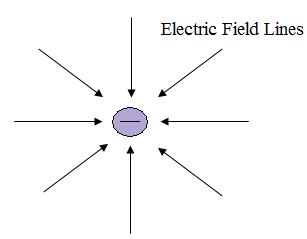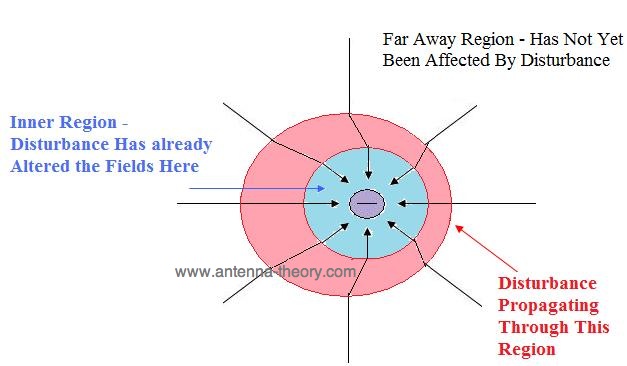Why do Antennas Radiate?
Obtaining an intuitive idea for why antennas radiate is helpful in understanding the fundamentals of antennas. On this page, I'll attempt to give a low-key explanation with no regard to mathematics on how and why antennas radiate electromagnetic fields.
First, let's start with some basic physics. There is electric charge - this is a quantity of nature (like mass or weight or density) that every object possesses. You and I are most likely electrically neutral - we don't have a net charge that is positive or negative. There exists in every atom in the universe particles that contain positive and negative charge (protons and electrons, respectively). Some materials (like metals) that are very electrically conductive have loosely bound electrons. Hence, when a voltage is applied across a metal, the electrons travel around a circuit - this flow of electrons is electric current (measured in Amps).
Let us get back to charge for a moment. Suppose that for some reason, there is a negatively charged particle sitting somewhere in space. The universe has decided, for unknown reasons, that all charged particles will have an associated electric field with them. This is illustrated in Figure 1.

Figure 1. A negative charge has an associated Electric Field with it, everywhere in space.
So this negatively charged particle produces an electric field around it, everywhere in space. The Electric Field is a vector quantity - it has a magnitude (how strong the field strength is) and a direction (which direction does the field point). The field strength dies off (becomes smaller in magnitude) as you move away from the charge. Further, the magnitude of the E-field depends on how much charge exists. If the charge is positive, the E-field lines point away from the charge.
So this negatively charged particle produces an electric field around it, everywhere in space. The Electric Field is a vector quantity - it has a magnitude (how strong the field strength is) and a direction (which direction does the field point). The field strength dies off (becomes smaller in magnitude) as you move away from the charge. Further, the magnitude of the E-field depends on how much charge exists. If the charge is positive, the E-field lines point away from the charge.
The universe has also decided (again, for no apparent reason) that disturbances due to moving (or accelerating) charges will propagate away from the charge at the speed of light - c0 = 300,000,000 meters/second. This means the electric fields around the charge will be disturbed, and this disturbance propagates away from the charge. This is illustrated in Figure 2.

Figure 2. The E-fields when the charge is accelerated.
Once the charge is accelerated, the fields need to re-align themselves. Remember, the fields want to surround the charge exactly as they did in Figure 1. However, the fields can only respond to events at the speed of light. Hence, if a point is very far away from the charge, it will take time for the disturbance (or change in electric fields) to propagate to the point. This is illustrated in Figure 2.
In Figure 2, we have 3 regions. In the light blue (inner) region, the fields close to the charge have readapted themselves and now line up as they do in Figure 1. In the white region (outermost), the fields are still undisturbed and have the same magnitude and direction as they would if the charge had not moved. In the pink region, the fields are changing - from their old magnitude and direction to their new magnitude and direction.
Hence, we have arrived at the fundamental reason for radiation - the fields change because charges are accelerated. The fields always try to align themselves as in Figure 1 around charges. If we can produce a moving set of charges (this is simply electric current), then we will have radiation.
Now, you may have some questions.
First - if all accelerating electric charges radiate, then the wires that connect my computer to the wall should be antennas, correct? The charges on them are oscillating at 60 Hertz as the current travels so this should yield radiation, correct?
Answer: Yes. Your wires do act as antennas. However, they are very poor antennas. The reason (among other things), is that the wires that carry power to your computer are a transmission line - they carry current to your computer (which travels to one of your battery's terminals and out the other terminal) and then they carry the current away from your computer (all current travels in a circuit or loop). Hence, the radiation from one wire is cancelled by the current flowing in the adjacent wire (that is travelling the opposite direction).
Another question that will arise is - if its so simple, then everything could be an antenna. Why don't I just use a metal paper clip as an antenna, hook it up to my receiver and then forget all about antenna theory?
Answer: A paper clip could definitely act as an antenna if you get current flowing on the antenna. However, it is not so simple to do this. The impedance of the paper clip will control how much power your receiver or transmitter could deliver to the paper clip (i.e. whether or not you could get any current flowing on the paper clip at all). The impedance will depend on what frequency you are operating at. Hence, the paper clip will work at certain frequencies as an antenna. However, you will have to know much more about antennas before you can say when and it may work in a given situation.
--------------
In summary, all radiation is caused by accelerating charges which produce changing electric fields. And due to Maxwell's Equations, changing electric fields give rise to changing magnetic fields, and hence we have electromagnetic radiation. The subject of antenna theory is concerned with transferring power from your receiver (the energy is contained in voltages and currents) into electromagnetic radiation (where the energy is contained in the E- and H-fields) travelling away from the antenna. This requires the impedance of your antenna to be roughly matched to your receiver, and that the currents that cause radiation add up in-phase (that is, they don't cancel each other out as they would in a transmission line). A multitude of antenna types produce ways of achieving this, and you can find descriptions about them on the antenna list page.
来源:http://www.antenna-theory.com/basics/whyantennasradiate.php
无论在哪里做什么,只要坚持服务、创新、创造价值,其他的东西自然都会来的。






【推荐】国内首个AI IDE,深度理解中文开发场景,立即下载体验Trae
【推荐】编程新体验,更懂你的AI,立即体验豆包MarsCode编程助手
【推荐】抖音旗下AI助手豆包,你的智能百科全书,全免费不限次数
【推荐】轻量又高性能的 SSH 工具 IShell:AI 加持,快人一步
· SQL Server 2025 AI相关能力初探
· Linux系列:如何用 C#调用 C方法造成内存泄露
· AI与.NET技术实操系列(二):开始使用ML.NET
· 记一次.NET内存居高不下排查解决与启示
· 探究高空视频全景AR技术的实现原理
· 阿里最新开源QwQ-32B,效果媲美deepseek-r1满血版,部署成本又又又降低了!
· AI编程工具终极对决:字节Trae VS Cursor,谁才是开发者新宠?
· 开源Multi-agent AI智能体框架aevatar.ai,欢迎大家贡献代码
· Manus重磅发布:全球首款通用AI代理技术深度解析与实战指南
· 被坑几百块钱后,我竟然真的恢复了删除的微信聊天记录!